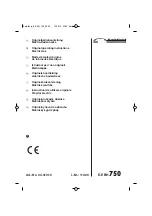
JOHNSON CONTROLS
28
Form 160.00-N6
Issue date: 08/27/2021
Section 3 - Installation
• Verify that the power modules are correctly con-
nected and that there was no damage during ship-
ping or handing.
• Verify that there are no loose connections or wires
and that all of the required shipping split connec-
tions have been made.
• Verify all external control circuit wiring is com-
plete and correctly connected.
• The three-phase source power must be within the
correct voltage and frequency tolerances.
• The motor leads must be connected to terminals
T1, T2, and T3.
• Verify that all grounding connections are correct-
ly connected.
• Make sure there are no short circuits or inadver-
tent grounds and tighten any loose connector ter-
minal screws.
Device/mechanism check
• All devices are to be checked for damage. Make
all necessary repairs or replacements.
Do not energize damaged equipment
that has not been properly repaired and
verified.
• Ensure that all safety signs are visible and not ob-
scured.
• All switches, relays, and other operating mecha-
nisms must be manually exercised to make certain
that they are properly aligned and operate freely.
• Operating mechanisms such as interlocks, switch-
es, and others, must be checked for function as in-
tended for protection of personnel and equipment.
• Check fan overload relays to make sure that they
are selected and adjusted to the proper settings.
•
Power circuit fuses must be verified to be selected
and installed in accordance with the unit parts list.
Fuses must be completely inserted in their hold-
ers.
Electrical checks
• An electrical insulation test must be performed to
ensure that the MVVSD and associated field wir
-
ing are free from short circuits and grounds. The
preferred method is to perform a dielectric test at
2.25 times the nominal system voltage plus 2,000
V. This must be done phase-to-ground, and phase-
to-phase, with all switches and circuit breakers
opened. Disconnect any devices that may have
limited dielectric strength and that are not intend-
ed for this test, such as the input surge suppres-
sors.
The light or buzzer, or both, used to indicate
breakdown must be calibrated to indicate fail-
ure with an output current between 1.5 mA and
2.0 mA per 1,000 V applied.
Hazardous voltages are present during
dielectric testing, which can result in
serious injury or death. High potential
tests must be performed only by qualified
personnel. Refer to safety instructions
provided with the test equipment.
• All devices must be set to their normal OFF posi-
tion before energizing incoming power.
•
All field wiring must be in accordance with the
current edition of the NEC, as well as all other ap-
plicable codes and specifications. Refer to the ap
-
plicable, Field Connections Wiring Diagram for
the chiller model being connected to this panel.
Initial energization
Energizing a MVVSD for the first time is potentially
dangerous. Only qualified personnel, as defined in the
MVVSD overview section of this manual, must ener-
gize the equipment. If faults caused by damage or poor
installation practices have not been detected in the pre-
energization check section, major damage including
personal injury can result when power is applied. Extra
precaution is recommended on the initial energization
of the equipment.
Hazardous Voltage. Incorrectly installed
or damaged equipment can result in
severe injury, death, and property loss.
Correct all problems before energizing
this equipment.





































